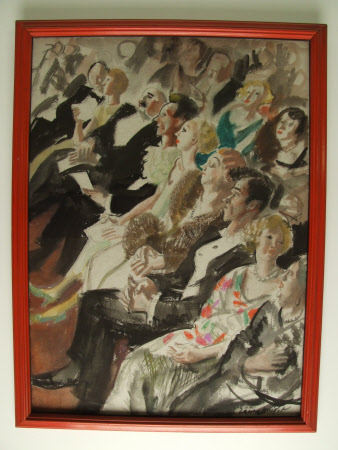First Night in the Stalls
Dame Laura Knight (Long Eaton, Derbyshire 1877 – St. John’s Wood 1970)
Category
Art / Drawings and watercolours
Date
circa 1932
Materials
Pencil and watercolour on paper
Measurements
397 x 286 mm (15 6/12 x 11 1/4 in)
Place of origin
London
Order this imageCollection
Shaw's Corner, Hertfordshire
NT 1275267
Caption
‘I am thankful to have known the tasks and struggles of common life, joy and despair like any other mortal. I am just a hard-working woman who longs to pierce the mystery of form and colour.’ These powerful lines appear in Laura Knight’s second autobiography, The Magic of a Line, published to coincide with her large retrospective exhibition (the first of its kind for a woman) at the Royal Academy of Arts in 1965. During the course of an extraordinarily productive career spanning over seven decades, Knight was one of the most distinguished artists of her day. She portrayed a diverse range of sitters, from staff and patients at a racially segregated hospital in Baltimore in the USA, and members of the Women’s Auxiliary Air Force, to subjects from the worlds of the circus, ballet and theatre. On seeing his finished portrait, an astonished George Bernard Shaw told Knight that she made him appear to be a sincere man, ‘when all my life I have been an actor’. During the Second World War, under commission from the War Artists’ Advisory Committee chaired by the art historian Sir Kenneth Clark (1903–83), she often argued that she should be better remunerated. Educated at a time when studying life-drawing was the preserve of male artists, Laura Knight overturned the social restrictions of the day by establishing her own life studio. Hers was a career of firsts: the first woman artist to be made a Dame of the British Empire in 1929, and in 1936 the first woman elected to full membership of the Royal Academy since founding members Angelica Kauffman and Mary Moser in 1768. Throughout Knight’s professional career she worked in a wide variety of media. In the 1930s she was commissioned to design commemorative ceramics, including a mug for Burgess & Leigh Ltd to celebrate the coronation of Edward VIII. The same year, Wedgwood’s Etruria factory commissioned her to produce a loving cup, the design later adapted for the coronation of George VI. Instead of using more traditional tropes of royalty, she portrays a circus elephant – symbolising the British Empire – opposite St George and the Dragon. Towards the end of her long life she stated, ‘my inner self continues to say even today – go on, keep on trying something different’.
Summary
Pencil and wash on paper, "First Night in the Stalls", by Dame Laura Knight (Long Eaton, Derbyshire 1877 – St. John’s Wood 1970). The first two rows of seats in the stalls curve across the picture, the men in white tie and tails, the women in silk dresses and pearls. Bernard Shaw was friends with the artist Dame Laura Knight for many years, first meeting her through the theatre impresario Sir Barry Jackson at the Malvern Theatre Festival in 1932. Knight’s watercolour painting First Night in the Stalls, painted at Malvern during the early 1930s, reveals not the performance at the theatre, but the audience – reflecting the importance of the viewing public in Shaw’s world.
Full description
Bernard Shaw was friends with the artist Dame Laura Knight (1877-1970) for many years, first meeting her through the theatre impresario Sir Barry Jackson at the Malvern Theatre Festival in 1932. Knight’s watercolour painting First Night in the Stalls, painted at Malvern during the early 1930s, reveals not the performance at the theatre, but the audience – reflecting the importance of the viewing public in Shaw’s world. Shaw was fond of having his portrait made, so it is no surprise that Laura Knight also painted Shaw’s portrait at Malvern. Knight in fact painted Shaw at Malvern whilst he was sitting for his bust by Sigismund De Strobl (the bust was donated by Shaw to the National Theatre). In Shaw’s autobiographical work Sixteen Self Sketches (1949) he included a photograph of himself with Knight and Strobl at Malvern in 1932. Further photographs of Knight were taken by Shaw at this time. (NT 1715220.50; 1715224.11). In her autobiography, Knight recalls that she found it difficult to work alongside another artist using a different medium. Knight also made a charcoal sketch of Shaw entitled George Bernard Shaw Posing for His Bust. The large oil portrait of Shaw dating to 1933, is in the collection of Hereford Museum and Art Gallery; whilst the charcoal sketch is at the Nottingham Castle Museum. (See Rosie Broadley, Laura Knight Portraits, National Portrait Gallery, 2013, pp.110-11). Knight created a poster design for Shaw’s play Too True to be Good, which had its British premiere at the Malvern festival on 6 August 1932. There is a label on the back of the painting from Deighton’s Strand Gallery. This gallery was well-known during the 1930s as a fine art dealers and frame makers – it was located off Trafalgar square, near to the Shaws’ flat at Whitehall Court. Charlotte Shaw’s cheque books in the British Library show that she paid several cheques to the gallery for framing pictures during the 1930s. (Alice McEwan, 2020)
Provenance
The Shaw Collection. The house and contents were bequeathed to the National Trust by George Bernard Shaw in 1950, together with Shaw's photographic archive.
Credit line
Shaw’s Corner, The George Bernard Shaw Collection (National Trust)
Marks and inscriptions
(Paper label on back from Deighton's Strand Gallery)
Makers and roles
Dame Laura Knight (Long Eaton, Derbyshire 1877 – St. John’s Wood 1970) , artist
References
Conroy, Rachel, Women Artists and Designers at the National Trust, 2025, pp. 202-207

